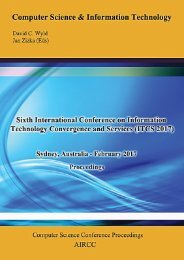CoSIT 2017
Fourth International Conference on Computer Science and Information Technology ( CoSIT 2017 ), Geneva, Switzerland - March 2017
Fourth International Conference on Computer Science and Information Technology ( CoSIT 2017 ), Geneva, Switzerland - March 2017
You also want an ePaper? Increase the reach of your titles
YUMPU automatically turns print PDFs into web optimized ePapers that Google loves.
Computer Science & Information Technology (CS & IT) 89<br />
The financial institutions’ server converts customers’ passwords into a custom hash using the<br />
algorithms they first used to create the hash (i.e., when the user first set up the account’s<br />
password), and checks for a match. If it matches, the customer is allowed to access the account. If<br />
it does not match, the server may allow a few more tries before locking the account. In addition to<br />
this process, financial intuitions often ask for more verification if their customer is signing in<br />
from a new device. This extra step involves one or more security questions that the user provided<br />
answers to when they first set up their account’s credentials. The extra step is an added security<br />
measure to ensure that even with the hacked password, the attacker would have one more<br />
challenge before gaining access to the account. With the current practices, there are variations to<br />
these steps. Hence, not all financial institutions follow a standard mechanism for authenticating<br />
their users’ access. For instance, some may display a predefined image for identification of the<br />
legitimate versus fake website that was made to look like their financial intuition’s website.<br />
Others may ask for the username on the home page but not password at first, until the user clicks<br />
the sign-in, continue, or next button. There is also the second authentication using a code that is<br />
delivered either via email, phone, or a mobile app. In general terms, the extra steps may consist of<br />
some other information that the owner of the account knows other than their password which<br />
financial institutions can ensure it is indeed the owner of the account that is attempting to<br />
accessing the account. Therefore, a hacker has to break down at least two barriers to gain access<br />
to the account. While this process works well in practice, developers designed it for the humans'<br />
capabilities, and not for machines. Thus, financial institutions had to make their interface easy<br />
enough for human use, as well as appealing to the masses that use online services. That is, the<br />
login credentials used in current practices are a compromise between security and user’s<br />
convenience.<br />
2.2. Current Infrastructure Shortcomings<br />
The infrastructure of online accounts lacks the mechanisms to support a different form of account<br />
authentication with restrictive access. As a result, users are giving their personal access<br />
credentials to third-party companies to utilize the financial services they provide. With everincreasing<br />
cyber-security threats, coupled with the existing industry practices, users may make<br />
themselves vulnerable to cyber criminals. The current practices have created a challenging and<br />
engaging problem that needs to be solved to keep the users safe from potential cyber-attacks.<br />
The following is a list of potential problems with the current infrastructure:<br />
• Users are making themselves vulnerable by giving their banking credentials in the form<br />
of username/password plus security questions and answers to third-party companies.<br />
• The users’ credentials are designed to be private and not shared with others.<br />
• Once users’ credentials are given to a third-party company, they can be stored on their<br />
server, which may be exposed to an attacker.<br />
• Users may use the same username/password for other accounts or other places, and as a<br />
result, if an attacker steals their credentials, they can access more than just that account.<br />
• Current bank accounts are full-access accounts, and as a result, once a third-party<br />
company has access to these accounts, they can perform transactions on that account.<br />
• Financial institutions are not the only company that always allow full-access once users’<br />
credentials are entered. Hence, other online accounts that users share with others may be<br />
at risk of being vulnerable to an attacker.





